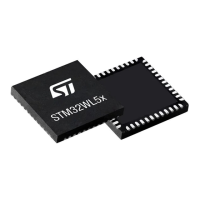RM0453 Rev 2 603/1454
RM0453 Digital-to-analog converter (DAC)
617
19.4.12 DAC channel buffer calibration
The transfer function for an N-bit digital-to-analog converter (DAC) is:
Where V
OUT
is the analog output, D is the digital input, G is the gain, V
ref
is the nominal full-
scale voltage, and V
os is the offset voltage. For an ideal DAC channel, G = 1 and Vos = 0.
Due to output buffer characteristics, the voltage offset may differ from part-to-part and
introduce an absolute offset error on the analog output. To compensate the V
os, a calibration
is required by a trimming technique.
The calibration is only valid when the DAC channel is operating with buffer enabled
(MODE1[2:0] = 000b or 001b or 100b or 101b). if applied in other modes when the buffer is
off, it has no effect. During the calibration:
• The buffer output is disconnected from the pin internal/external connections and put in
tristate mode (HiZ).
• The buffer acts as a comparator to sense the middle-code value 0x800 and compare it
to VREF+/2 signal through an internal bridge, then toggle its output signal to 0 or 1
depending on the comparison result (CAL_FLAG1 bit).
Two calibration techniques are provided:
• Factory trimming (default setting)
The DAC buffer offset is factory trimmed. The default value of OTRIM1[4:0] bits in
DAC_CCR register is the factory trimming value and it is loaded once DAC digital
interface is reset.
• User trimming
The user trimming can be done when the operating conditions differs from nominal
factory trimming conditions and in particular when V
DDA
voltage, temperature, VREF+
values change and can be done at any point during application by software.
Note: Refer to the datasheet for more details of the Nominal factory trimming conditions
In addition, when V
DD
is removed (example the device enters in STANDBY or VBAT modes)
the calibration is required.
The steps to perform a user trimming calibration are as below:
100
Sample and
hold mode
Enabled
Connected to external pin
101
Connected to external pin and to on chip peripherals (such as
comparators)
110
Disabled
Connected to external pin and to on chip peripherals (such as
comparators)
1 1 1 Connected to on chip peripherals (such as comparators)
Table 116. Channel output modes summary (continued)
MODE1[2:0] Mode Buffer Output connections

